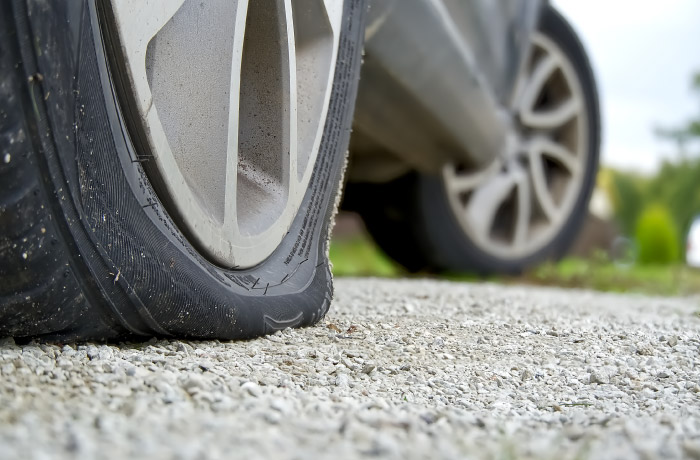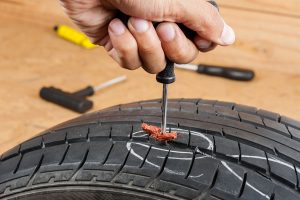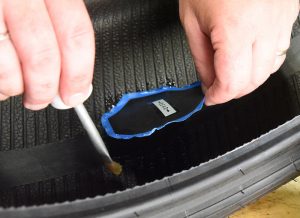

Flat tires, blown-out tires, and shredded tires are all extremely common occurrences, especially when driving through areas that are under construction. Running over a nail can be very upsetting and may leave you wondering what the best way to repair your tire is in instances like this.
Tire repairs come in many different shapes and forms and are highly dependent on how severe the damage is to the tire. Most simple damages can be repaired with either a plug or a patch, but which option is better?
First, let’s break down what exactly tire plugs and radial patches are.
What is a Tire Plug?

A tire plug is a sticky, expandable piece of rubber that gets inserted into the hole from the outside and seals the tire. Tire plugs take very little time to install and can be done without removing the tire from the wheel, and in some cases, while the tire is still attached to the vehicle. The plug should stay intact well enough to safely get to a repair shop.
What is a Radial Patch?

A radial patch is a flat piece of rubber with an adhesive back that is placed on the inside of the tire to repair the damage. These are typically stronger than plugs but require more work as the tire does need to be removed from the vehicle and the wheel. As the air pressure is put back into the tire, the patch expands and melds to the tire forming one solid piece.
So Which is Better?
First, there are a few factors to take into account:
1. When can you use a plug on a tire?
When choosing to plug or patch a tire, it often depends on the size of the hole and the location. Plugs are typically used for small punctures. Be sure not to plug your tire if:
- it’s anywhere near the sidewall.
- it’s an irregularly shaped hole.
- it’s a large hole or thick nail.
- you’ve run the tire while it was flat for more than a mile, this can mean that the sidewalls are damaged.
- there’s a bubble or bulge in the rubber on the sidewall.
When can you patch a tire?
Patches are better than plugs for bigger holes, holes closer to but not the sidewall, and holes that aren’t completely straight. Be sure not to patch your tire if:
- it’s near the sidewall.
- it’s larger than a quarter of an inch.
- you already have damaged sidewalls.
- there’s a bubble or bulge in the rubber on the sidewall.
- there’s another patch in a nearby place on the tire.
- unless you’ve removed it from the wheel and checked for other holes/issues.
2. The safety of use
Both the US Tire Manufacturers Association (USTMA) and the Tire Industry Association (TIA) have their own safety standards for tire repairs. These standards must be upheld if the tires are to be considered safe after the repair. Doing a tire repair yourself is not advisable unless it is a very straightforward instance.
How safe is plugging a tire?
When driving, as your tires heat up, they will expand. A tire plug is made of a different rubber compound than tire rubber which means they expand at different rates. If you are repairing your tire yourself with a plug, you are solely relying on whether or not you properly plugged the hole. The plug needs to withhold the friction, expansion, and contraction when your tire heats up and cools off.
Plugging a tire can also trap air between the layers of the tread. When dipping the plug into the glue and inserting it in the hole, you are gluing it to every layer it passes through. As the tire heats up. The air between the layers expand and has nowhere to go causing the tread to separate from the rest of the tire.
How safe is patching a tire?
Radial patches are designed to repair radial tires which are most of the tires on the road today. When your tire heats up, the patch “melts” into the tire. If the tire is patched, the patch prevents any air from inside the tire from escaping. It also allows any air trapped between the layers to escape out of the entrance hole in the outer tread area.
Though you do have to remove your tire to install the patch, it is safer to do so. Without properly inspecting the inside of the tire for hidden damage comes with risk. This is not to say that in some cases a plug wouldn’t serve as a temporary low-speed solution, but if a tire is punctured while you are not near an auto repair shop, a patch would be the safer option.
Radial Patch is the Winner!
The Rubber Manufacturers Association (RMA), refers to a tire industry study that showed that nearly 88 percent of tire repairs are performed improperly. They also suggest that any tire repair done without removing the tire to inspect and determine the extent of the damage is an improper repair and could pose a safety hazard and could also affect the manufacturer’s warranty.
Overall, a radial patch is a safer, long-term solution. Plugs should be used as a temporary repair until you can have the tire taken off of the rim and inspected from the inside, then patched.
Always remember that any tire damage should be repaired immediately, even if your tire is still holding air but has a small leak. Small damages can lead to harmful accidents which can be easily avoided with a repaired tire. Your tires need to be maintained on a regular basis for damage, wear and tear, and lifespan. Whether you have a flat tire, a damaged tire, a small leak, or just need your tires checked, Luke’s Auto Service located on Grove Avenue in Verona, NJ is always here to help keep you safe and on the road!
References/Image Sources:
